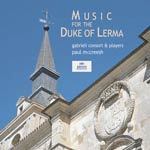
Music of the Duke of Lerma (works by CabezAn-GaudA-Gombert-Guerrero etc)
 $54.89
Special Order
$54.89
Special Order3 - 6 weeks add to cart
Music of the Duke of Lerma (works by CabezAn-GaudA-Gombert-Guerrero etc)
Gabrieli Consort and Players. Paul McCreesh TO BE DELETED AUG 2006
[ Archiv / 2 CD ]
Release Date: Saturday 1 June 2002
This item is only available to us via Special Order. We should be able to get it to you in 3 - 6 weeks from when you order it.
Editor's Choice - Gramophone Magazine (Jan 2003)
"Grand, late-Renaissance Spanish music in the ideal setting of Seville Cathedral . Ever since Paul McCreesh won a Gramophone Award for his stunning 'Venetian Coronation' reconstruction on Virgin Classics back in 1990, he has been exploring lavish musical occasions, both sacred and secular, with his Gabrieli players. This latest extravaganza whisks us back to 1617 to the church of La Colegiata de San Pedro in Lerma in mid-northern Spain and to an event designed by the Duke to curry favour with King Philip III - which it did, albeit briefly." (Gramophone)
In 1617, a year before his downfall, Don Francisco de Sandoval, Duke of Lerma, put on a lavish display of his power, a sort of ultimate swan song. The entire Spanish court assembled for two weeks in Lerma to enjoy entertainments.
The motivating factor behind this occasion was the re-consecration of the collegiate church of San Pedro, upon which Lerma lavished enormous expense. The endowment also included a large number of instruments as well as a substantial collection of music, most notably some 50 books from an auction of the Flemish royal chapel.
After the re-discovery of the collections, which Douglas Kirk identified as the most important collection of wind instruments of the time, he won over Paul McCreesh and for five years the two worked together in the collegiate church of San Pedro, gathering documents that would form the basis of the new recording.
For the recording McCreesh and Kirk made use of a full range of period instruments, some of them specially reproduced for the occasion, such as the typically Spanish bajoncillos, small dulcians used by the Gabrieli Consort here for the first time. They also made use of the two organs at San Pedro.
Tracks:
Anonymous (-)
Canción (untitled) a 6
[1:50]
Antonio de Cabezón (1510-1566)
Tiento para organo: Verso II, glosado en el tiple, Tono V
[0:57]
Gregorian Chant
Deus in adjutorum - Domine ad adjuvandum
[1:00]
Sacerdos in aeternum Christus (Antiphona)
[0:45]
Mateo Romero (1575-1647)
Dixit Dominus (Psalmus) a 16
[3:32]
Gregorian Chant
Sacerdos in aeternum Christus (Antiphona)
[0:48]
Miserator Dominus (Antiphona)
[0:48]
Antonio de Cabezón (1510-1566)
Confitebor tibi (Psalmus), alternatim fabordones Tono II
[5:46]
Gregorian Chant
Miserator Dominus (Antiphona)
[0:50]
Calicem salutaris accipiam (Antiphona)
[0:37]
Philippe Rogier
Credidi (Psalmus), alternatim fabordones a 5, Tono III
[5:54]
Gregorian Chant
Calicem salutaris accipiam (Antiphona)
[0:39]
Sicut novellae olivarum (Antiphona)
[0:43]
Antonio de Cabezón (1510-1566)
Beati omnes (Psalmus), alternatim fabordones del cuarto tono
[4:36]
Gregorian Chant
Sicut novellae olivarum (Antiphona)
[0:46]
Qui pacem ponit fines Ecclesiae (Antiphona)
[0:44]
Francisco Guerrero (1528-1599)
Lauda Jerusalem (alternatim fabordones a6 /a 4)
[5:26]
and much much more
